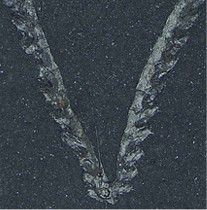Joe has told me that I write far too many blog posts about food. So, since we promised lots of posts about geology, and have managed hardly any, here is one on graptolites.
No, not the latest diet fad, but a type of fossil. This one is called Dicellograptus cambriensis*, from the Ordovician (about 450 million years ago) of Wales. Each of the branches is about 2 cm long. This is one of average-ish size, but they ranged from a couple of millimetres to more than a metre and a half long. As with most fossils, their soft tissue has rotted away, and only the more decay-resistant part is left. This is made of a protein similar to collagen (what your skin is made from).
Graptolites were animals, and the ones that most graptolite workers study** floated/swam*** in the sea during the Ordovician, Silurian and Devonian periods (between about 488 and 407 million years ago)****. Their main use is for dating rocks - they are found all over the world, there were many different species, and most of the species did not exist for very long. This means that if you look in rocks of the right type, you're likely to find graptolites. If you know which species you are looking at, you know exactly how old the rocks are. This is useful if you are looking for oil, trying to find gold, or are just trying to make an accurate geological map.
Of course, I still haven't told you much about what they actually were. That's because we don't know very much. We know a lot about the structure of their skeleton - in the example here, each branch is a series of tubes piled up obliquely. Each protrusion on the branches is the mouth of a tube. We know that they were colonial, like a coral, with individuals living in the tubes. However, we don't know how many individuals lived in each tube. Was there one big animal per tube (like one of their living relatives) or several small ones (like their other living relative)?
So, we know a lot about graptolites in terms of which species lived when, and which species evolved into which others. We know very little about them as living animals though, and that is the part that I find most interesting.
Lucy
*The fossil name ought to be in italics, but I don't seem to be able to do that via flickr, so please just pretend the italics are there.
**There are a number of other types, but we don't usually talk about them.
***I am being deliberately vague, but they definitely did one or the other, or possibly both. Ask two graptolite workers and you'll get three different opinions.
****There are relatives of graptolites living today, but unless you have a zoology degree you probably won't have heard of them. If you're interested, the names to look up are Rhabdopleura and Cephalodiscus.


No comments:
Post a Comment